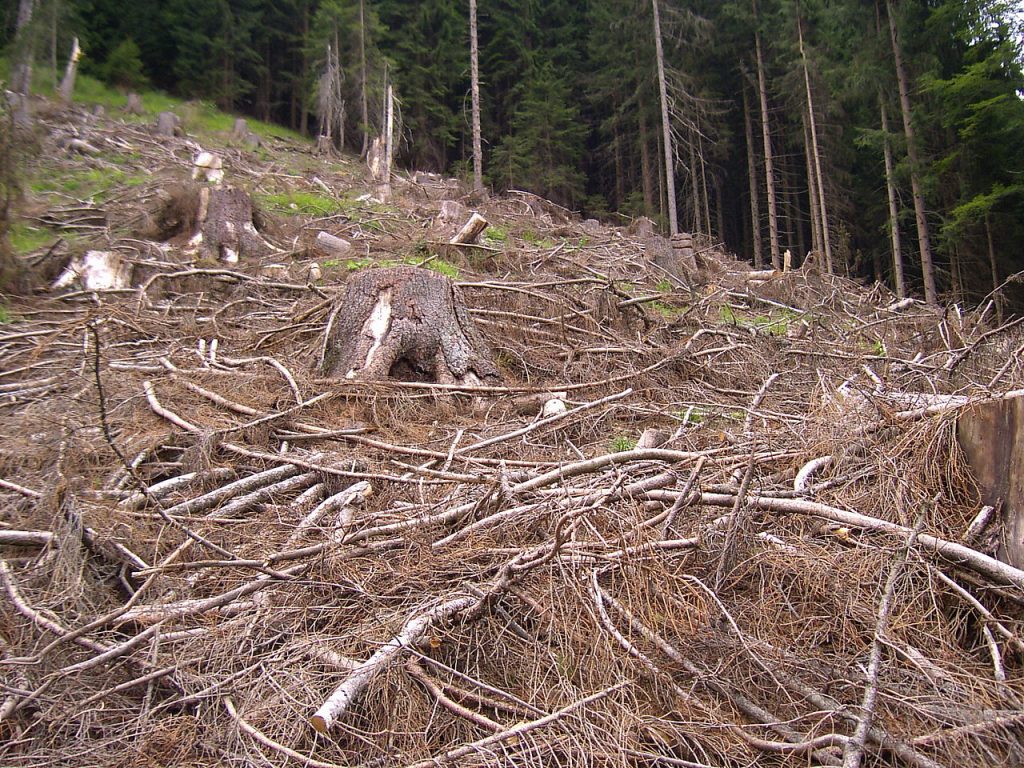Forests cover more than a third of the European Union’s territory: they store carbon, harbour precious biodiversity and support rural activities. Forest protection – which lies at the crossroads of climate and biodiversity – was made a political priority within the framework of the 2019 European Green Deal, the ambitious roadmap to make the EU the first carbon-neutral continent by 2050. The objective was twofold: to reduce greenhouse gas emissions by 55% by 2030 and to protect at least 30% of the EU’s land area, including 10% under strict protection.
This transformative vision was reinforced by several parallel strategies: the European Climate Law, the Biodiversity Strategy for 2030, and the European Forest Strategy for 2030. Together, they call for a fundamental reform of our relationship with ecosystems and recognise that European forests are under increasing pressure from intensive exploitation, monocultures, droughts, fires and biodiversity loss.
The stakes are especially high given that two-thirds of the EU’s forest area is concentrated in six member states: Sweden, Finland, Spain, Poland, Germany and France. In each of these countries, the forestry sector is of major economic importance and weighs heavily in political decisions and national industrial strategies.
But while the scientific findings are clear, recent political dynamics are taking a different direction. Swayed by economic pressures, geopolitical tensions and anti-regulation rhetoric, the political will behind Green Deal is faltering. Since 2023, there has been a deregulatory offensive seeking to dilute, slow down or block several key instruments: the Nature Restoration Law (NRL), the EU Deforestation Regulation (EUDR), the Land Use, Land-Use Change and Forestry (LULUCF) regulation, and the Forest Monitoring Law (FML).
While forests should be a central lever for climate action and biodiversity protection, they now risk becoming collateral victims of a political U-turn in Europe. This article looks at three major policies and how the European environmental project is being unravelled.
Headwinds begin to blow for forest protection
With the proposed Nature Restoration Law (NRL), the European Commission took a historic step: for the first time, a binding legislative framework would require member states to restore a significant proportion of degraded ecosystems, marking a shift towards a policy of ecological repair rather than mere preservation.
But this ambitious and transformative law quickly became caught in a political struggle, becoming the first visible target of the anti-environmental offensive underway in Brussels. In June 2023, the European People’s Party (EPP) under the leadership of Manfred Weber surprised everyone by taking a firm stance against the text, going so far as to attempt to have it rejected outright. The groupings to the right of the EPP also opposed the bill. The vote in the ENVI (Environment) Committee on 15 June was close to being cancelled, with a tied result: 44 votes in favour, 44 against.
On 20 June the Council of the EU, representing all member states, responded by adopting a text that made concessions on implementation of regulation, including on the monitoring of forest ecosystems, while maintaining the targets and the incentive mechanisms for sustainable management. At the European Parliament’s plenary vote, the Nature Restoration Law was narrowly adopted, thus saving part of its initial ambition.
In addition to the ‘anti-green politics’ sentiment fuelled by conservatives, pressure came from the Swedish, Finnish and Estonian forestry sectors, which since Russia’s full-scale invasion of Ukraine in 2022 have been calling for forests to be exempt from restoration obligations. These countries are among the most forested in the EU, and their forestry industries play a major economic role. The political weight of these national industries has led to several deadlocks in European negotiations.
But many foresters – notably a large French contingent committed to more nature-friendly management – have expressed their support for the legislation. Thanks to such shows of support alongside appeals from thousands of citizens, scientists and NGOs, the attempt to sabotage the Nature Restoration Law failed, which was narrowly approved in the European Parliament. Nevertheless, the law was weakened and pressure continued to mount against other forestry regulations. This scaling back of ambition is all the more worrying given that only 14% of protected European forests are currently considered to be in ‘good ecological condition’, according to official European data.
The fight against imported deforestation
The anti-regulatory campaign gained momentum after the 2024 European elections. This can be explained by the rise of far-right forces and their alliance with the centre right against the European Green Deal.
This alliance was evident in the attacks on another pioneering European law on forests: the EU Deforestation Regulation (EUDR), which came into force in 2023 and aims to combat deforestation in tropical forests caused by Europe’s demand for products like cocoa, soy and rubber – referred to as ‘imported deforestation’. However, the law also aims to halt the ‘degradation’ of forests in Europe, an endemic problem where industrial forest management is leading to the conversion of diverse forests into monocultures.
Despite its widespread popularity – 84% of citizens surveyed in seven member states said they were in favour of its rapid implementation, and more than 1.2 million signatures were collected in support of the law – the text has been the subject of repeated attempts to weaken it, particularly by the European forestry industry.
In early October 2024, the European Commission proposed postponing the law’s implementation by one year. The European People’s Party (EPP) – through the German MEP Christine Schneider, who has close ties to the timber industry – took advantage of the vote on postponing the law to launch a political offensive to reopen the content of the regulation, proposing amendments that would effectively strip it of its substance.
The alliance between far-right groups and the EPP resulted in the European Parliament voting on amendments that would allow European member states to avoid being ‘covered’ by the law’s requirements. Germany and Austria, whose conservative MEPs are very close to their agricultural and forestry sectors, denounced the EUDR as a ‘bureaucratic monster’ and argued that there was no deforestation taking place in Europe. What they did not mention is that the EUDR would call into question the European forestry industry’s economic model, which is based on clear-cutting – an operation that removes all trees in the landscape, often leading to the destruction of diverse habitats that are later replaced by rows of planted trees.
This procrastination provoked irritation from countries with high forest cover around the world, who saw it as an attempt to favour European companies. On 3 December 2024, after a month of ‘drama’, inter-institutional negotiations between the Commission, Parliament and Council resulted in a formal agreement: the regulation would come into force one year late, but without any changes to its environmental obligations.
Unfortunately, even this agreement continued to be challenged, and pressure on the EUDR continues. In October 2025, the European Commission came forward with a proposal for delay, which member states in the Council took as an opportunity to propose simplification of reporting requirements on where timber and other commodities are sourced. This would increase the likelihood that deforestation and forest degradation go unnoticed. It remains to be seen how the European Parliament will position itself on this proposal to weaken the content of the law.
Opposition to showing what is happening in forests
Behind its technical appearance, the proposed Forest Monitoring Law (FML) has crystallised unexpected political tensions. What was supposed to be a consensual text aimed at improving the collection and quality of forest data in Europe has turned into what observers call a ‘toxic’ debate.
Why oppose better information on the state of forests? Poor-quality data – incomplete, obsolete or erroneous – has concrete negative effects: ill-adapted business strategies, compliance issues, ineffective public decisions. Unclear or missing information on, for example, changes in forest cover (i.e. whether trees are standing or felled in areas classified as a forest), impacts of fires or droughts, or the location of highly biodiverse forests creates massive barriers to protecting forests and the environment more broadly from climate impacts.
Scientists and professionals widely recognise the need to improve forest data. Researchers and companies using Earth Observation tools are calling for harmonised monitoring at European level. The FML could meet this need by creating a common framework for satellite observation and field data collection, while ensuring data security. This would make it possible to monitor key indicators such as the scale and impact of logging, the presence of primary forests which are particularly biodiverse, or forest structure which can differentiate tree crops that grow at the same height or more natural forests. Such a system would be useful to everyone: public decision-makers, foresters, researchers and NGOs. It would also provide a strategic tool for adapting the forestry sector to the effects of climate change, while helping to secure the supply of wood for European industries.
But the European forestry industry is once again working to weaken this text. It does not want a more open debate on industrial forest management. In the European Parliament, conservative and far-right MEPs have proposed scrapping the proposed law. Other groups, as well as some member states, want to completely abolish satellite monitoring, even though it is essential for detecting illegal logging, monitoring old forests and observing signs of decline.
If the FML – an essential transparency tool – were to be withdrawn in response to political calls to ‘simplify’ EU laws, this would set a dangerous precedent that serves to further weaken European coordination. It would also be a collective failure for innovation and modernisation in the forestry sector. Refusing information often means refusing to act. If governments and industry lobbies oppose a law such as the FML, we must question their motives: what do they have to hide when they block the means that would allow us to see the state of our forests clearly?
Vested interests
Since September 2025, the EU has bowed to concerted pressure from the pulp and paper industries by embarking on a course to diminish the ambition of its Land Use, Land-Use Change and Forestry (LULUCF) regulation. This regulation accounts for emissions from the land use and forests sector.
On 15 September, the Swedish and Finnish governments placed a target on the EU’s carbon forest sink ambition. In a letter to the European Commission, they outlined how they would not meet LULUCF goals, blaming changes in forest age structure, climate change, droughts, pests and decreasing forest growth. In addition to these factors, they cited Russian aggression and the resultant increase in prices and demand for forestry products.
Finnish and Swedish NGOs responded swiftly to debunk their governments’ arguments. They pointed out the megatons of carbon dioxide equivalent they will miss their targets by, underscoring that this failure is a choice their governments are making, despite the alarms raised repeatedly by scientists and experts. But on 5 November 2025, the Environment Council heeded industry pressure, stating that the Commission should pay particular attention to the competitiveness of ‘traditional industries, notably … pulp and paper’.
It is now expectated that the legislation will be reviewed prematurely next year and that the text will be weakened, despite the urgent need for accelerated action on declining forest carbon sinks.
In May 2025, the European Commission’s Joint Research Centre insisted that faster action must be taken against biodiversity loss, saying that ‘although significant steps have been taken to develop and implement policies to reduce impacts on biodiversity, they are not yet sufficient to halt biodiversity loss and reverse the decline’.
But now, even the policies that have been put in place are being called into question. This creeping deregulation affects other issues, such as setting climate targets for 2040, currently under discussion, where the forestry industry and certain states are arguing for less ambition in relation to land use – much of which is forest management.
More than ever, citizens must mobilise to preserve Europe’s environmental ambition.







